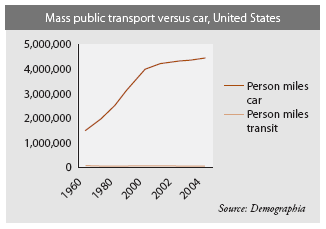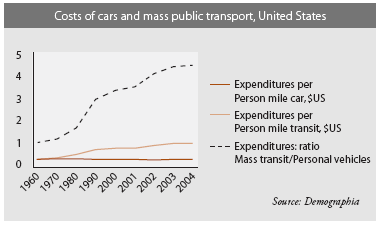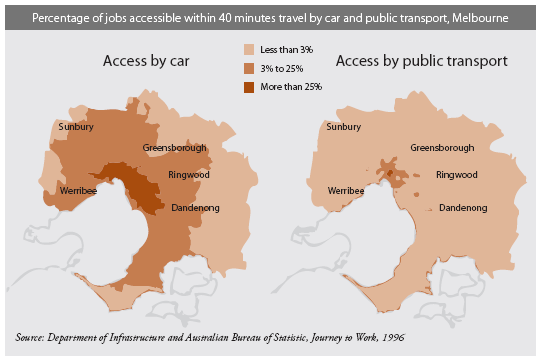When US journalist Lincoln Steffens returned from Russia in 1921, he famously declared “I have seen the future and it works”. As we now know, the future that did actually work was not the socialism he admired but free enterprise and consumer sovereignty. Transport and urban planning generally is the last redoubt of the socialism much admired by yesteryears’ elites.
As to what actually works in the future, then and today, this is best observed in the US itself. In the case of urban change and the transport needs this brings, the US remains the best guide, in part because it tends to have multiple jurisdictions that both learn from each other and are somewhat in competition. If one city departs from allowing genuine consumer needs to be fulfilled, it faces competition from others that are more responsive to the needs of consumers, workers and commerce.
The pattern of transport in the US reveals a sharply declining share of public transport within the overall transport market. In terms of car versus transit, the following illustrates this. Since the 1960s, mass transit has dropped from a previously minuscule 3 per cent share to 1 per cent of the market. The dramatic loss of business by transit is reflected in its increased costs. Notwithstanding energy crises and taxes, the cost of moving people by transit, relative to cars, has vastly increased.
Advertisement
Back in 1960, both modes cost about the same at a little over 20 cents per person mile. Car travel has remained at about that level but transit costs have risen to 95 cents per person mile - four-and-a-half times the cost of car travel.

Trends in Melbourne
Melbourne has shown comparable trends. Data on the Demographia site show that Melbourne is one of only three cities from 100 around the world with recently increased shares for transit (in all three cases the increases were minuscule).

But over the past half century, public transport as a share of passenger trips in Melbourne has fallen from 57 per cent to about 8 per cent. In the process, public transport has moved from turning a modest profit to being subsidised to the tune of about 80 per cent of overall costs.
The Government says it is to roll back this long-term trend of patronage loss by public transport. It wants to see public transport providing 20 per cent of all motorised trips by 2020.
Advertisement
Melbourne 2030’s ambitious goal for shifting mode choice across the metropolitan area between 1995 and 2020 involves the following:
- car use is intended to decrease from 74 per cent of all trips to roughly 60 per cent;
- public transport use is intended to increase from 7 per cent of all trips to roughly 15 per cent; and
- walking and cycling are intended to increase from 19 per cent of all trips to roughly 25 per cent.
Such a reversal of previous trends would be unprecedented in any country in the world. Even icon cities such as Portland, which have implemented tough anti-parking restraints and spent a fortune on light rail, have seen transit patronage grow by less than a percentage point.
Undeterred, to approach its goals, the government has set out a Plan (Meeting our transport challenges). Over the coming decade, this allocates for Melbourne about $6,035 million for transit and $2,155 million for roads.
Thus, the car, comprising 92 per cent of the motorised market and contributing a massive net revenue in taxation, is to be outspent almost 3:1 by transit which currently has 8 per cent of the market and in the widely optimistic forecast of The Plan might have 15 per cent.
Transit’s ability to meet consumers’ needs
In spite of public transport benefiting from massive subsidies, the coverage of its ability to carry people to their destinations quickly is highly restricted. Add to this the convenience in leaving home or work when you wish, and comfort, and the task confronting transit becomes colossal.
The problem is graphically demonstrated by the government in the following map of the accessibility of jobs in Melbourne by car and transit.

The map is designed as ammunition for those seeking to boost transit spending, but actually it merely shows the enormity, the impossibility, of the task of forcing more people off cars and on to transit. A casual examination of the dark and light areas illustrates the magnitude of the task in reversing the on-going trend away from transit uses.
Compared to public transport, people find cars to be more convenient and lower cost. Importantly, transit finds itself on the wrong side of history. It can only operate effectively in urban conditions and only really effectively in urban areas with high densities and concentrated origin and destination points. A rule of thumb is that, to be commercially viable, rail-based systems require 40,000 people per square kilometer and express bus systems 25,000.
Melbourne has an average density of 1,500 and reaches a maximum of 5,500 only in the densest suburb. Transit’s disadvantages are compounded by the changing nature of cities themselves. Less than 50 years ago, 55 per cent of Melbourne’s jobs were in the central area. Today, it is 28 per cent and only 10 per cent work in the area we call the Central Business District. Work locations, which were once dictated by the availability of mass transit and tended to be located in the central areas of the city, are now becoming far more dispersed.
This is partly due to the nature of work itself - far more is undertaken at diffuse locations because of a reduction in factory sizes, telecommunications advances and a shift towards services that do not require traditional employee concentrations.
It also reflects people’s preferences - a great many people, even those with access to free transit travel, choose to use their cars because they are more convenient.
Transport as a service
Transport is a derived demand. In other words, not many people get in their car or hop on a tram just for the pleasure of doing so. People use transport to get from A to B. They wish to do so as quickly as possible with constraints on price and comfort, and so on. This did not appear to have been a priority for the Victorian Government that identified problems of transport in Melbourne 2030, which instead focused on equity, pollution and the like.
The root cause of any transport problems we have is this determination to give people what the government and certain elites think is good for them rather than what they themselves want. Such arrogant dismissal of people’s own preferences is an endemic problem with urban planning.
We can see the same philosophy in the rationing of land (under the guise of zoning) that artificially raises the cost of housing on the periphery and, as a result, throughout the conurbation. In part this policy is motivated by a desire to ensure that cities are more compact and therefore susceptible to public transport. In part it is to bring about a density that is thought to be necessary to foster the positive externalities of the city - patronage to allow for lively restaurants, theatre and cinema.
In some cases this is a nostalgia for a bygone age which may never really have existed. The teeming city that was 19th century Paris, London, Vienna or even New York and Melbourne has passed into history. It has done so because few wanted to live within it given the choice. And transport innovations gave people that choice.
The cities we now think of with affection are highly concentrated shells of leisure and shopping services. In many cases they incorporate a sort of Disneyesque preservation of the more attractive parts of their historic architecture and sometimes this is superimposed on on-going office employment. Nobody would dream of setting up heavy industry or transport-intensive services in these cores.
Attaining and delivering the full suite of services that the concentrated core once delivered is impossible. Attempting to reach that goal will be costly and could throttle the city as a commercial entity. The policy of re-creating a version of the compact city is foundering on the shoals of what people actually want. Given the choice, most people want to live in their own detached home with some land attached to it. They are less enamoured than the elites about living close to the centre. And almost everyone now owns, or has access to, a car - most families have at least two.
(In Palo Alto, the capital of the world’s IT industry, the main shopping centre is not served by transit and there is not even a taxi rank.) Even so, the minority who do not have a car or access to one is paraded as a rationale for the vast reallocation of taxes towards transit and away from improving the carrying capacity and efficiency of the road system.
What is to be done?
The transport task is to seek out needs and adapt the city to them. This remains an anathema to many, just as it was when De Gaulle declared in the 1960s that Paris must adapt to the car.
De Gaulle recognised that for Paris to remain a major commercial, administrative and cultural centre it needed to develop beyond being a mere relic of the past. To some degree this was successful, but Paris, for all its attractions, has become a shell of several hundred thousand people surrounded by apartments and urban developments similar to those found throughout the world.
For Australian cities such as Melbourne, Sydney and the other three major capitals with cores that provide a concentrated location for office work and leisure activities, there will remain a role for transit. Rail and bus services remain efficient means of getting large numbers into the sort of CBD that major Australian capital cities have and should continue to have.
For the main part, however, cities should adapt to the car and the truck. Road systems are far and away more important than fixed track systems, and buses can make good use of them. Given Melbourne’s topography and road systems, trams work well, but their intrinsic high costs and inflexibility are the reasons why Melbourne is one of only a handful of world cities retaining them other than as bit players and for tourism reasons.
The greater task of transport of people and freight alike must be by private cars and trucks. It is therefore vital that the road system be upgraded to keep pace with the demand for car transportation, consistent with the cost effectiveness of this.
At its most fundamental, this conforms to the wishes of the individuals who comprise the community, wishes that are expressed in their transport choices. At its more mundane, it means governments should simply maintain and develop the roads by which prosperity is maintained. What needs to be avoided at all cost is a repetition of policies, like those of the Cain Government, which were deliberately designed to reduce the efficiency of expressways (the South East “Arterial” was so named and designed to appease transport unions who resisted greater patronage by cars).
All this means that inevitable revisions of Melbourne 2030 must progressively wind back the ratio of road to transit expenditure. The most favourable car to transit ratio that can be reasonably expected is about 12:1. Even excluding the operational deficits of transit, the proposals in the Victorian Government’s Plan, Meeting our transport challenges, has transit expenditures threefold those on roads. This is a vast waste of taxes and needs to be brought into line with the underlying demand for transport services.